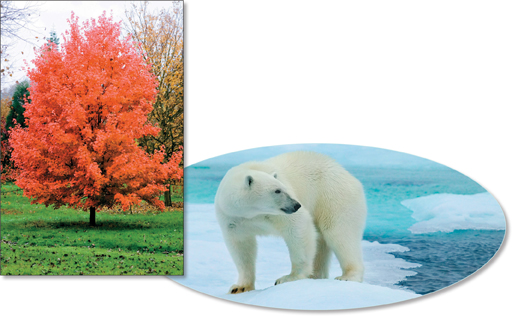Binomial Nomenclature In the 1730s, Swedish botanist Carolus Linnaeus, developed a two-word naming system called binomial nomenclature.  In binomial nomenclature, each species is assigned a two-part scientific name. Scientific names are written in italic. The first word begins with a capital letter, and the second word is lowercased.
In binomial nomenclature, each species is assigned a two-part scientific name. Scientific names are written in italic. The first word begins with a capital letter, and the second word is lowercased.
The polar bear in Figure 18–3 is called Ursus maritimus. The first part of the name—Ursus—is the genus to which the organism belongs. A genus (plural: genera, JEN ur uh) is a group of similar species. The genus Ursus contains five other species of bears, including Ursus arctos, the brown bear or “grizzly.”
The second part of a scientific name—in these examples, maritimus or arctos—is unique to each species. A species, remember, is generally defined as a group of individuals capable of interbreeding and producing fertile offspring. The species name is often a description of an important trait or the organism's habitat. The Latin word maritimus, refers to the sea, because polar bears often live on pack ice that floats in the sea.
 In Your Notebook The word binomial means “having two names.” How does this meaning apply to binomial nomenclature?
In Your Notebook The word binomial means “having two names.” How does this meaning apply to binomial nomenclature?
MYSTERY CLUE

Polar bears and brown bears inter-breed and produce fertile hybrids in zoos, but they very rarely interbreed in nature. What do you think this means about the relationship between them?

FIGURE 18–3 Binomial Nomenclature The scientific name of the polar bear is Ursus maritimus, which means “marine bear.” The scientific name of the red maple is Acer rubrum. The genus Acer consists of all maple trees. The species rubrum describes the red maple's color.
Classifying Species Into Larger Groups In addition to naming organisms, biologists also try to organize, or classify, living and fossil species into larger groups that have biological meaning. In a useful classification system, organisms in a particular group are more similar to one another than they are to organisms in other groups. The science of naming and grouping organisms is called systematics (sis tuh MAT iks).  The goal of systematics is to organize living things into groups that have biological meaning. Biologists often refer to these groups as taxa (singular: taxon).
The goal of systematics is to organize living things into groups that have biological meaning. Biologists often refer to these groups as taxa (singular: taxon).
Whether you realize it or not, you use classification systems all the time. You may, for example, talk about “teachers” or “mechanics.” Sometimes you refer to a smaller, more specific group, such as “biology teachers” or “auto mechanics.” When you do this, you refer to these groups using widely accepted names and characteristics that many people understand. In the same way, when you hear the word bird, you immediately think of an animal with wings and feathers.
Table of Contents
- Formulas and Equations
- Applying Formulas and Equations
- Mean, Median, and Mode
- Estimation
- Using Measurements in Calculations
- Effects of Measurement Errors
- Accuracy
- Precision
- Comparing Accuracy and Precision
- Significant Figures
- Calculating With Significant Figures
- Scientific Notation
- Calculating With Scientific Notation
- Dimensional Analysis
- Applying Dimensional Analysis




